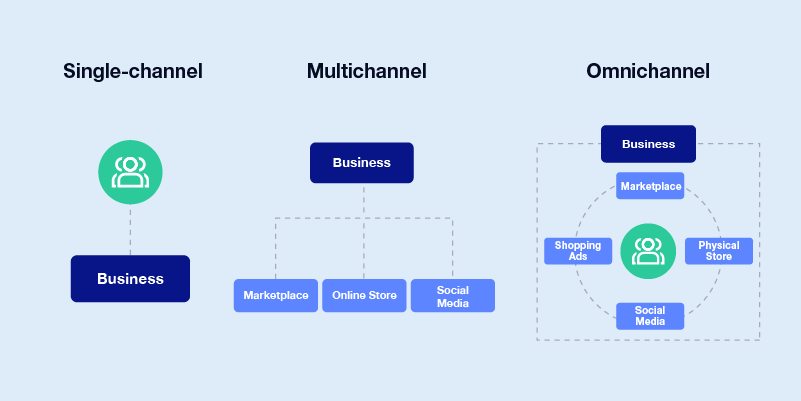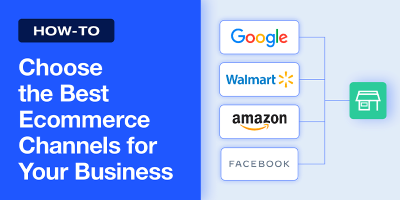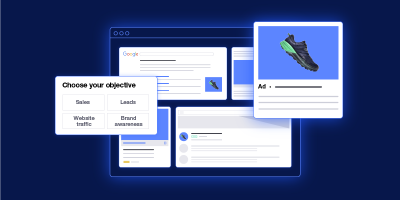At Sendlane’s Commerce Roundtable, Colin Madden, our Senior Director of Sales, and Mitch McKay, the Senior Strategic Partnerships Manager at BigCommerce, discussed the shift toward omnichannel and how to remain on the cutting edge of ecommerce.
In this blog, we expand on their topics of discussion and offer some insight on next steps and key considerations.
What is omnichannel?
Omnichannel is an integrated approach to multichannel commerce that syncs data between online-and-offline channels while keeping the customer at the center of the brand’s digital ecosystem. A traditional multichannel strategy has a linear design, feeding information from your data source to multiple channels and back again. Omnichannel is more fluid and allows a brand to link those touchpoints together and create a unified customer experience.
“It’s about delivering that consistent brand experience across specific channels that help meet your customer’s needs,” McKay said.

Adopting an omnichannel strategy improves the customer experience by creating a more convenient and personalized shopping journey. Rather than having a single, fixed approach to purchasing, omnichannel enables the customer to use the method that works best for them. This customer-centric model increases buyer satisfaction by providing a more tailored experience.
The benefits of omnichannel have made it a growing trend, but thoughtful implementation is the key to success.
The Four Pillars of Omnichannel Success
McKay explained the “Four Pillars of Omnichannel Success” that are essential for businesses to understand.

Source: BigCommerce
Pillar 1: Channels
Before you begin, you must answer two questions: who are your customers, and what channels are they on? Understanding your customer is important for determining how you tackle this first pillar. For example, if your product’s demographic skews to an older audience, a channel like TikTok may not be the best choice for the first channel you include in your omnichannel mix.
Pillar 2: Marketing
In addition to selecting your channel mix, you need to determine how to invest your marketing spend on those channels. What kind of advertising campaigns best help you reach your customers? Do you want to promote your brand, your products, or a mixture of different ad types? Partnering with the right ad platforms can have a positive impact on your success.
Pillar 3: Operations
Operations management is also an integral part of the omnichannel experience. If your products are available on multiple marketplaces, it is necessary to have visibility into all aspects of the customer journey. Operations include managing product inventory, ensuring that each marketplace has up-to-date information, and making sure your advertising campaigns are updated regularly based on performance metrics.
Pillar 4: Fulfillment
Finally, fulfillment. The customer journey does not end until the customer receives their order. As your business expands to additional marketplaces, this crucial step becomes harder to complete. Maintaining a consistent fulfillment rate increases customer loyalty and has the potential to extend the customer’s overall lifetime value.
How to unlock omnichannel success with your ecommerce business
Data feed management is one of the fundamental pieces of an omnichannel strategy. Synchronizing high-quality product data across your channels and systems drives better performance and streamlines your operations. Colin Madden expanded upon this idea with steps to help prepare your data for omnichannel.
- Collect data from all of your sources. The main idea here is to gather all of your product data in one place. Whether that’s within an Excel spreadsheet or exported from a Product Information Management (PIM) system, having all of your data readily available best prepares you for the next step.
- Populate your feed with key attributes. These attributes should be industry-specific. For example, products in a furniture category have different attributes than cosmetics products (e.g., material type, finish, assembly requirements, etc.). The more data you keep in your catalog, the better. This is your master resource for all of your data feeds.
- Optimize your data for each channel. Each marketplace and advertising channel has different feed requirements, style guides, and best practices. Take the needed attributes from your master feed and build individual feeds for each platform.
- Ensure orders sync back to you. This step is easy if you have a dashboard that can sync all of your product and customer order data. If not, you should create an organized system for all of your channels to keep track of this information and regularly process orders.
- Monitor your channel performance. Again, this is made easier with an ecommerce management dashboard, but is also possible with an organized system of reporting platforms.
Expanding from a single marketplace to hundreds of channels can be a tedious and time-consuming challenge. That is why many ecommerce retailers turn to a product feed management solution.
Better data, better performance
With optimized data, you give your products the best chance of ranking higher on your sales and ad platforms. Higher rankings mean you reach more customers and increase your chances of conversion.
“I can promise you that there is no channel where less data is going to give you better performance,” Madden said. “You need to be thinking holistically. On a per-channel basis, ask yourself, ‘Am I using the right descriptions? Am I using the right imagery?’”
Scale your business efficiently with the right tools
Partnering with the right data feed management platform and channel manager makes all the difference in executing an omnichannel model. As an example, Madden highlighted BigCommerce’s newest multi-channel manager, which fully integrates with the Feedonomics platform for feed optimization.
“With native integrations, you can rapidly expand your portfolio and hit millions of potential shoppers,” Madden said. “With the time saved, you can focus on other opportunities for expanding your business.”
For more omnichannel insight, watch the full webinar and Q&A.
Are you ready to expand your business to omnichannel? Our feed experts can help you build a comprehensive plan of action to expand your ecommerce business.

With its leading data feed management platform, Feedonomics helps brands, retailers, and agencies optimize and list products on hundreds of shopping destinations around the world. Learn more about our full-service solutions for advertising channels and marketplaces.




